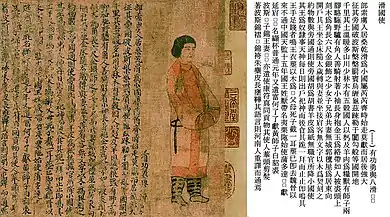Pei Ziye
Pei Ziye (裴子野, 471-532) was a Chinese historian of the southern Liang dynasty.[3] He was the son of another historian, Pei Yin (裴駰), a grandson of the famous historian Pei Songzhi. Pei Ziyi is, among other things, known for making a mistaken conjecture about the origin of the Hephthalites, who just sent an embassy at the Chinese court of the Liang dynasty in 516 CE,[4] saying that they may be descendants of the Jushi based on a false etymology. This account appears in the Liangshu (Volume 30):[3][5]
是時西北徼外有白題及滑國,遣使由岷山道入貢。此二國歷代弗賓,莫知所出。子野曰:「漢潁陰侯斬胡白題將一人。服虔《注》云:『白題,胡名也。』又漢定遠侯擊虜,八滑從之,此其後乎。」時人服其博識。
During this period, there were beyond the Northwestern frontier, the states of Boti and Hua, who sent envoys through the mountain road of the Min (river, in Sichuan) to offer tribute. These two states had not been guests of the successive dynasties, their origin was unknown. Ziye said: "There was Baiti, a hu general who was killed by Marquis Yingyin of Han. Fu Qian's commentary to the Hanshu says: 'Baiti is a hu name'. Moreover, it is known that the Marquis Dingyuan was accompanied by Bahua when attacking the Barbarians, so perhaps these two states are their descendants." His contemporaries admired his wide knowledge.

In effect, many foreign embassies visited the Chinese court at that time, and particularly three Hephthalite (Hua) ambassadors are known, who visited in 516–520 CE, and are described in the Portraits of Periodical Offering.[1][2]
The Emperor then ordered Pei Ziye to write an illustrated account of foreign embassies, Fangguoshitu (方國使圖),[6] which may have been the basis for the original Portraits of Periodical Offering of Liang, and the Hephthalites account of the Liangshu (Volume 54) , and this account again mentioned Pei Ziye's conjectural etymology.[3][5][7]
References
- DE LA VAISSIÈRE, ÉTIENNE (2003). "Is There a "Nationality of the Hephtalites"?". Bulletin of the Asia Institute. 17: 127-128. ISSN 0890-4464. JSTOR 24049310.
- DE LA VAISSIÈRE, ÉTIENNE (2003). "Is There a "Nationality of the Hephtalites"?". Bulletin of the Asia Institute. 17: 130, note 31. ISSN 0890-4464.
- DE LA VAISSIÈRE, ÉTIENNE (2003). "Is There a "Nationality of the Hephtalites"?". Bulletin of the Asia Institute. 17: 119. ISSN 0890-4464.
- KURBANOV, AYDOGDY (2010). THE HEPHTHALITES: ARCHAEOLOGICAL AND HISTORICAL ANALYSIS (PDF). Berlin: Berlin Freie Universität. p. 25.
- Balogh, Dániel. Hunnic Peoples in Central and South Asia: Sources for their Origin and History. Barkhuis. p. 46-47. ISBN 978-94-93194-01-4.
- "敕仍使撰《方國使圖》,廣述懷來之盛,自要服至于海表,凡二十國。"
- Yu, Taishan (Institute of History, Chinese Academy of Social Sciences). "The Illustration of Envoys Presenting Tribute at the Liang Court". Eurasian Studies. Volume VI: 93.